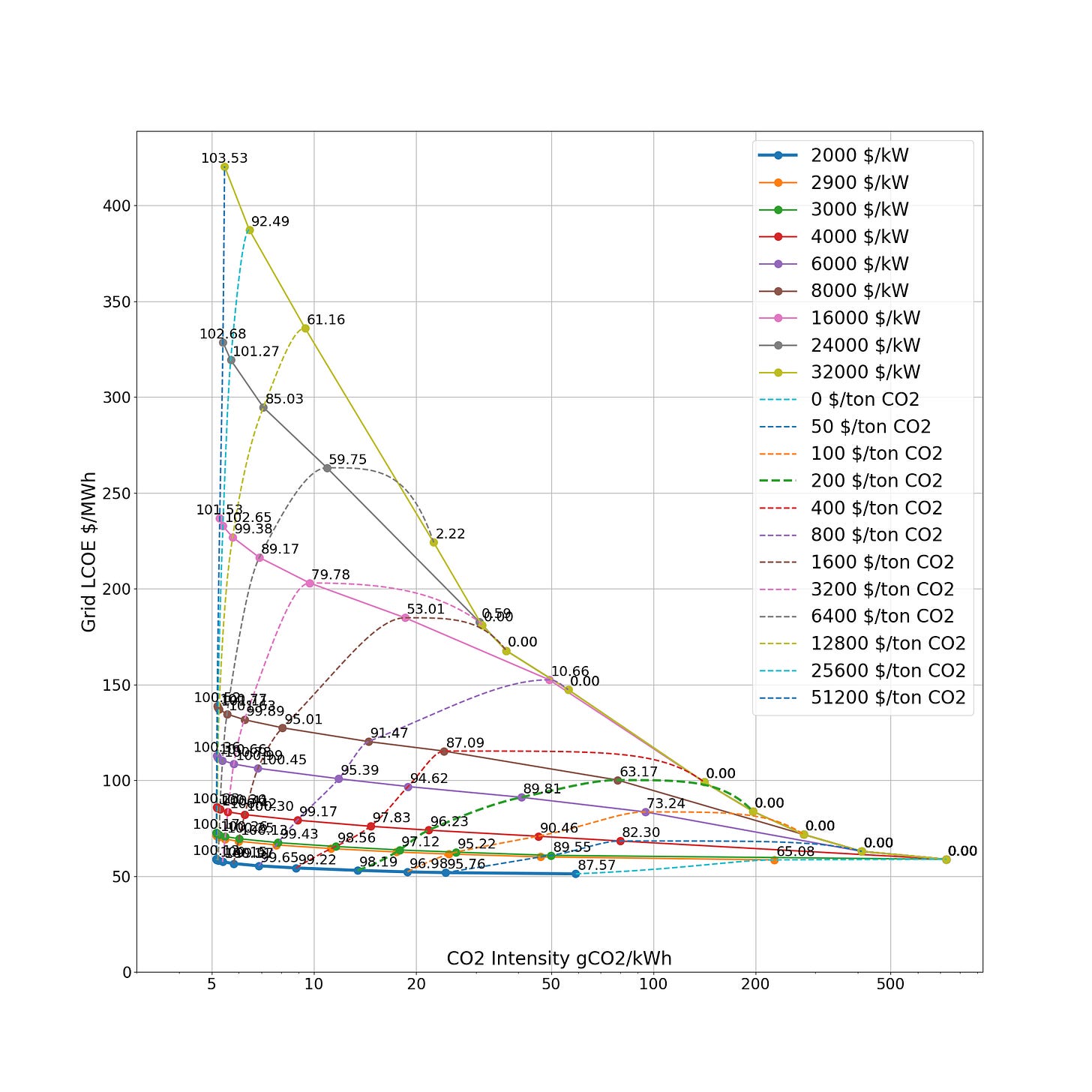The biggest health hazard of all is being poor
Or why I hate costly nuclear.
Figure 1. The Flop Book cover. Nearly one billion people have no or nearly no electricity.
An ugly form of optimism is infecting the US nuclear establishment and its supporters. All but the most rabid wind/solar promoters are beginning to realize you cannot feasibly build a reliable grid on weather dependent technologies. So if you want low CO2 electricity, you've got no where else to go but nuclear. You can almost hear the rubbing together of greedy hands.
Figure 2 shows how good it can be for the nuclear establishment. The figure shows the grid cost/CO2 intensity trade off curves for Germany. as a function of the Social Cost of CO2 (SCC) and nuclear's overnight CAPEX per kW (the cross plots). The colors show nuclear's market penetration, the ratio of nuclear power generated to demand.1
Figure 2. Contour Graph of Nuclear Market Penetration in Germany. For the assumptions underlying this figure, see Expensive nuclear's dirty secret. Each point on the grid is the combination of wind/solar/coal/gas/nuclear/batteries/H2 storage which is optimal for that Social Cost of CO2 and nuclear CAPEX.
A large portion of the figure is yellow or chartreuse which means a nuclear market penetration of more than 75%. For the members of the choir, who want to gloat over the actual juicy numbers, your helpful preacher offers Figure 3. For example, if the Social Cost of CO2 is $1600/ton, a number that has been seriously proposed, and nuclear's CAPEX is $16,000/kW, then nuclear's market penetration is 53%.
Why go lower? If we cut our CAPEX to $8,000/kW, our market penetration goes to 95%. We only increase nuclear capacity by a factor of 1.8 but our take per capacity is cut by a factor of 2.0. We'd have to produce nearly twice as much stuff for less money!!!
Figure 3. German Power Costs vs CO2 emissions for a range of nuke CAPEXes and SCC's. The cost of nuclear increases as you move from the Southwest to the Northeast. The Social Cost of Carbon increases as you move from the Southeast to the Northwest.
A CAPEX of $16,000/kW is starting to look about where we want to be. No wonder the itchy palms, the knowing smiles, and the visions of three homes. But to reach this nirvana, we must do two things:
a) Convince everybody CO2 is an immediate, existential threat. We don't have the time to decarbonize cheaply. We are pretty good at this, going back to Edward Teller's claim in 1959 that a 10% increase in atmospheric CO2 would put New York under water. (The actual increase since then of 30% has resulted in a sea level rise of 22 cm (9 inches).)
b) Above all, we must avoid competition. Competition would drive the cost of nuclear down vertically in the figures (without increasing CO2). So even if we accomplish (a), we'd end up with something like 10 times less money for producing more electricity.
Fortunately in the NRC, we have the ideal tool to squash competition. But the NRC's existence depends on convincing the public that a release is intolerable and the NRC can stop a release. Neither of the Two Lies is true. But it has worked so far; and we have new allies. Our new converts from the wealthy left are deeply distrustful of market solutions. They are natural supporters of NRC-style regulation. For the most part, we've duped them into believing the intolerable harm lie. With their help, we should be able to pull this massive scam off.2
Of course, there is one rather large group that will be left out. Only the very wealthy can afford 20 cents/kWh electricity before transmission and distribution. The nearly one billion people who have nil electricity will remain without power. Wealth requires electricity. A rough rule of thumb for developing economies is every kWh per capita consumed increase per capita GDP by five dollars. The several billion humans who could be lifted out of poverty by should-cost nuclear (the blue solid line at the bottom of Figures 2 and 3) will remain destitute.
Figure 4. Life expectancy versus GDP. Each dot is a country. The dots hide large intra-country disparities. In the USA, a wealthy country, the difference in years of life expectancy between the top 1% in income and the lowest 1% is 14.6 (men) and 10.1 (women).
Poverty is the biggest health hazard of all, Figure 4. Poverty has a Lost Life Expectacy(LLE) of the order of tens of billions of years per year. And we reject should-cost nuclear for fear of an occasional release that worst case, Chernobyl, properly handled, will have a public LLE of less than a 1000 years? This makes sense only if we assume a malthusian level of selfishness. But that is precisely where the nuclear establishment is.3
This ratio can be larger than 1.0. For extremely high SCC's, nuclear uses a combination of battery and H2 storage to handle peaking. But this means nuclear must produce more power than the demand to make up for the round trip losses. Kind of a bonus.
Even an effective monopoly is not enough for American nuclear. The piglets are also gathering at the public trough. The same people who were bashing tax credits for wind and solar, are now screaming bloody murder when Trump threatens to take them away from nuclear. Is there a uglier form of subsidy than a tax credit? They are a blatant, in your face, transfer of wealth from the poor to the rich.
We must avoid the mistake of thinking that because people believe bad ideas, they are bad people. It’s not that simple. I know quite a few members of the nuclear establishment and converts from the wealthy left. Most are good humans. Some are my friends. Reinhold Niebuhr once said
The problem of the age is not imposing morality on the individual, but imposing morality on the organization.
Niebuhr was not talking about the nuclear establishment. But he could have been.






I rarely compliment the choir, but I do want to give a shout out to the choristers for whom nuclear's main attraction is its low CO2. For them, this was a very tough sermon. It was a call to change focus, metanoeite if you will, from what nuclear can do for the climate to what nuclear can do for the poor, and for all humanity. That's not an easy switch. For one thing, it implies that costly nuclear is not good enough. It's immoral. We must have should-cost nuclear, and that will require a complete rethink about how we regulate nuclear.
I expected something like a 5% subscriber cancellation rate. Instead we lost 7 of 2900. I thought that was impressive.
Here's your reward. If and only if we push nuclear down to its should-cost, not only will nuclear push fossil fuel out of power generation except for a bit of peaking and backup fo r unplanned outages and do so automatically, not only will EV's now be very attractive economically, but now we can talk seriously about synfuels starting with synthetic methane.
I also hate costly nuclear.
I'd join any real movement to shift from conventional NRC-style regulation with a single agency given the monopoly on reactor licensing and operating approvals, especially when operating under an ALARA principle that effectively requires a never ending effort to reduce radiation doses.
But for now, my efforts and support are directed towards forcing NRC to improve and regulate with the presumption that nuclear energy is beneficial, especially compared to all other alternatives. I also like the idea of giving the NRC some competition by exercising DOE and DOD authorities.
As an investor, I'm also taking advantage of the international competition that the NRC already faces.
Like you, I like cheap nuclear power and believe we need to do everything we can to achieve the should cost level.
A final, slightly off topic comment, do you think that the oil and gas industry is any LESS greedy or willing to suppress competition than the established nuclear industry?